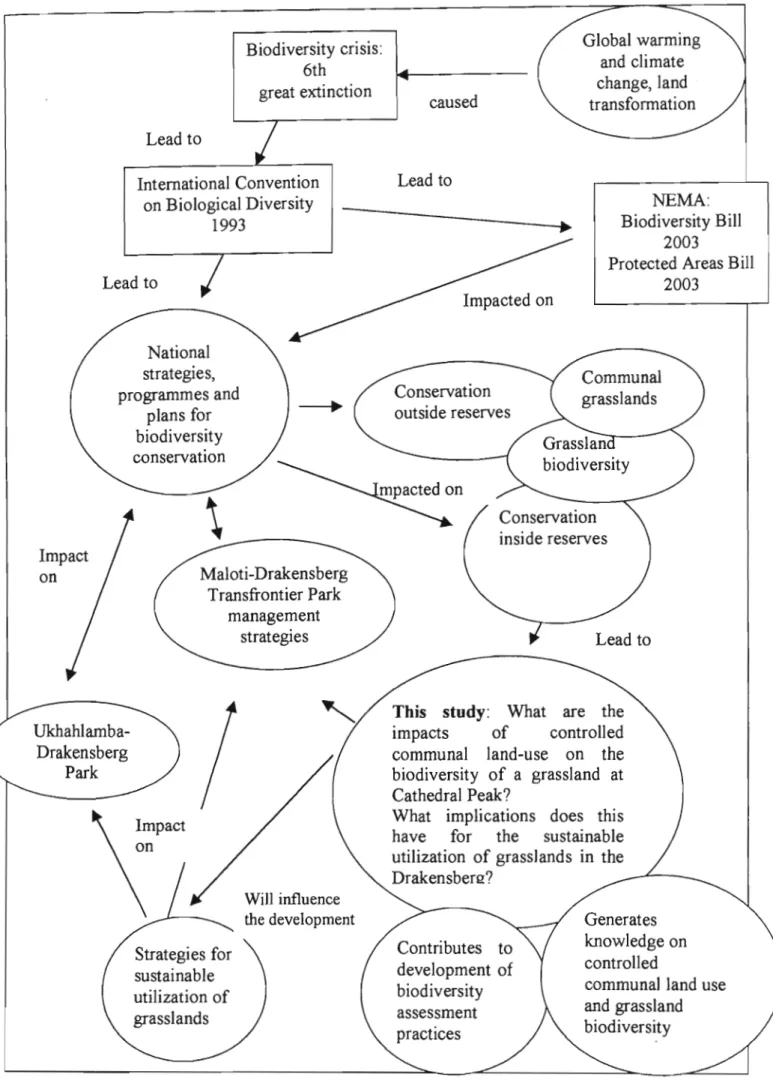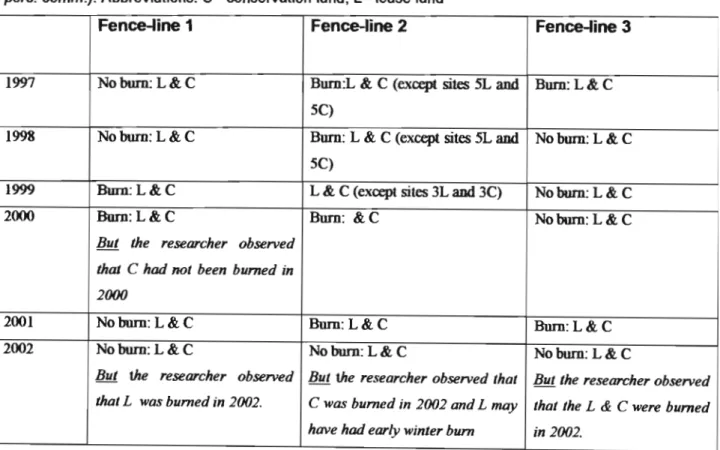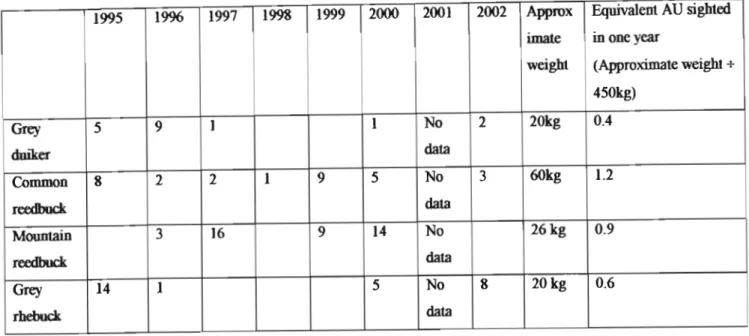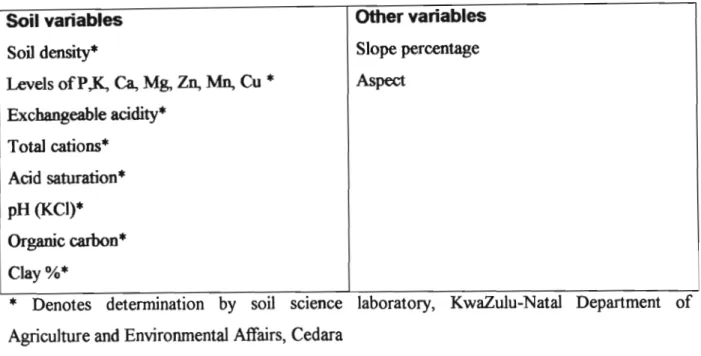Where the work of others has been used, this is duly acknowledged in the text. As a signatory to the Convention on Biological Diversity, South Africa has a responsibility to conserve biodiversity as well as to use it sustainably and fairly (Glowka, Burhenne-Guilmin, Synge, McNeely and Gundling 1994). To achieve these goals, South Africa is expected to develop national strategies, plans and programs (Department of Environmental Affairs and Tourism 1997).
At the same time, communal grasslands are considered to be among the most degraded in South Africa (Hoffinan and Todd 2000). This study focuses on a grassland in the Cathedral Peak area of the uKhahlamba-Drakensberg Park (UDP) which is located in the Eastern Mountain Center of Plant Diversity (CPD). DEAT (2002) recognized that the poor state of grassland conservation in South Africa needs to be addressed.
In the Drakensberg, conservation has largely meant the exclusion of grazing with fire, which is used to maintain grassland health. The Maloti-Drakensberg Transfrontier Park (MDTP) has been initiated in the eastern mountain region with the aim of conserving biodiversity as well as building the capacity of local communities in South Africa and Lesotho to manage their natural resources.
Problem statement
Rationale
A multidisciplinary approach was adopted and included botanical and zoological aspects of rangeland and rangeland science approaches, as well as a review of the changing context of conservation and development. There is a growing recognition that the sustainable use of rangelands requires a multidisciplinary approach to research and management (Thomas 1995, Cousins 1995). There is value in assessing the impact of low levels of grazing on rangeland biodiversity, a management approach that lies between continuous communal grazing and conventional rangeland conservation.
The findings of this study may provide a way forward for the design of buffer zones and low-use corridors outside core protected areas. In particular, it can offer strategies for MDTP that aim to conserve biodiversity while recognizing that local communities depend on grazing. This study deliberately included important but neglected components of biodiversity, such as grasses and invertebrates.
Grasslands make up the majority of grassland biodiversity (Scott-Shaw 1999), while invertebrates account for the majority of terrestrial biodiversity. Invertebrate groups are particularly useful in biodiversity assessment and management (Andersen et al. 2002) as they show rapid responses to environmental change (Rivers-Moore and Samways 1996).
Aims and objectives
Evaluate and compare the invertebrate and plant diversity and habitat condition in a low impact communally used area and the adjacent conservation land by means of a fence line study to measure the impact of communal land use. Make recommendations on the opportunities and threats posed by rural communities that have limited use of a conserved grassland. The following hypothesis was tested: There is lower biodiversity in the leased land at Cathedral Peak than in the adjacent conservation land.
Are there any differences in the diversity, evenness and species richness of plant communities between the leased land and the conservation land. Are there any differences in the diversity and species richness of invertebrate communities between leased land and conservation land? Have species been added or lost through different land uses and what is the importance of these species.
What is the impact of communal land use on field condition as a measure of ecosystem function in the tenancy. What are the implications of the findings for the conservation and sustainable use of grassland biodiversity.
Definition of key concepts
Controlled common land use was the use of the leased land for grazing in 3-month blocks twice a year. South Africa has one of the highest populations of threatened plants of any continental area in the world (Cowling and Hilton-Taylor 1994). In addition, the overall biodiversity of South Africa is one of the most threatened in the world (Wynberg 2002).
South Africa's conservation policy and legislation in the 21st century reflects the global acceptance of the sustainable development concept. Strategies of the poor and some problems of land reform in the Eastern Cape, South Africa. Observations were made of erosion of cattle tracks in the leasehold and the condition of the fences between leasehold and conservation land.
Further differences in the biodiversity of the two land uses were characterized by the large number of plant species (27%) and invertebrate morphospecies (27%) recorded only on the leased land, as well as plant species (29%) and invertebrate morphospecies ( 23%) were recorded only in the conserved land (Appendix 2,3 and 6). The eroded cattle tracks occurred within the leasehold and not along the fence line.

Study area
The lease land and the conservation land
The leasehold is situated on the boundary between the Cathedral Peak Protected Area and the communal lands of the adjacent amaNgwane tribe. The NPB's Conservation Committee supported the concept of a lease rather than a land swap. The World Heritage Convention (No. 49 of 1999), which provides for the implementation of the World Heritage Convention in South Africa.
The leased land consisted of 535 ha of upland grassland and is legally part of the Cathedral Peak protected area. Most of the more common species were found on both conservation and leasehold land. Further assessment of the impact of communal controlled grazing within the lease is recommended.

Literature review
Grasslands and biodiversity conservation
Most endemic plants in the Eastern Mountain Region are grassland bushes and low shrubs with very few endemic grasses (Cowling and Hilton-Taylor 1994). The Clementsian Succession Model based on theories of ecological succession in the climate-climax grasslands of the North American prairies (Tainton and Hardy 1999) has guided thinking about vegetation change in grasslands for half a century (Stafford-Smith and Pickup 1993). A number of ecologists in the early 1990s argued that a large amount of conflicting research results had been generated with a continuing lack of clarity about the effect of different land use practices (Stafford-Smith and Pickup 1993).
Ecologists who rejected the equilibrium model argued that heavy grazing, in the form of persistently high stocking rates in moist and soft grasslands, produced little change in species composition, basal cover, or primary productivity, and that recovery from drought or rest was rapid (Shackleton 1998). Fire exclusion was attempted in the Drakensberg grasslands in the mid-20th century, but later approaches included regular vagrants to prevent succession on 'false' grasslands. More recent research in the Cathedral Peak burn experiments found that plant diversity was more influenced by environmental gradients than boom treatments (Uys 2000).
Although ecological factors were taken into account in these measures, both approaches ignored the role of ecological diversity in ecosystem sustainability. In the late 20th century, the emphasis on soil erosion alone shifted to a more holistic, participatory land management ethic that linked conservation and production (Critchley and Netshikhovela 1998).
Communal grass lands and biodiversity conservation
The purpose of the study was to determine the impact of controlled use of municipal land on biodiversity. People and rangelands: building the future: proceedings of the Sixth International Rangeland Congress 2, Townsville, Queensland, Australia, 19-23 July 1999, Volumes 1 and 2. People and rangelands: building the future: proceedings of of the Sixth International Rangeland Congress 2, Townsville, Queensland, Australia, 19-23 July 1999, vols 1 and 2.
People and Rangelands: Building the Future: Proceedings of the Sixth International Rangeland Congress 2, Townsville, Queensland, Australia, 19-23 July 1999, voll and 2. People and Rangelands: Building the Future: Proceedings of the Sixth International Rangeland Congress 2, Townsville, Queensland, Australia, July 19-23, 1999, part 2. The influence of different burning treatments on the plant species diversity of the highland acidveld grasslands.
Most of the morphospecies strongly associated with the lease plots at fence line 2 were also recorded in the conservation plots with the exception of Orthoptera 77 which was absent from the conservation plot (Appendices 5,6). Despite the high scores for the condition of the vellum and the lack of significant difference in the richness, uniformity and diversity of the vegetation, there were signs of disturbance and selective grazing on the leased land. The assessment of the condition of the plants used in the vegetation survey is limited by the SUBJECTIVITY of the species classification and weighting system.
Methodology
Research description
People and Rangelands: Building the Future: Proceedings of the Sixth International Rangeland Congress 2, T ownsviUe, Queensland, Australia, 19-23 July 1999, Parts 1 and 2.







